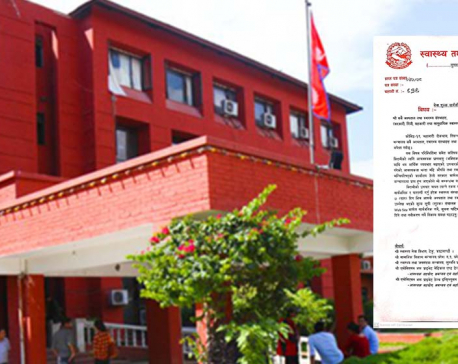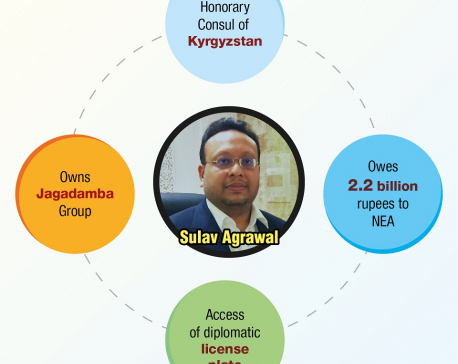
OR
Corruption rife in billions that govt spends on free kidney care
Published On: October 2, 2019 07:28 AM NPT By: SHREE RAM SUBEDI
KATHMANDU, Oct 2: The government is spending billions on free dialysis for patients with chronic kidney disease. But it is learnt that there is no standard operating procedure and hospitals are suspected of financial irregularities while claiming reimbursement from the government.
More than 4500 patients received the treatment and the government spent over Rs 1.3 billion on them every year.
The government has been providing free dialysis service to kidney patients since May 2016. A total of 12,062 patients have received such dialysis--which includes both hemodialysis and Continuous Ambulatory Peritoneal Dialysis (CAPD).
In hemodialysis, a dialysis machine and a special filter known as a dialyzer or artificial kidney is used to clean the blood. Considered a portable type of dialysis, CAPD uses manual bags containing peritoneal dialysis fluid that flows into the patient’s belly and collects excess water and waste, which is drained into another bag.
Free kidney treatment costs the government over Rs 1 billion every year, but there is lack of a standard protocol for treatment, quality of service or monitoring by the authorities, according to Shree Kidney Victims Concerned Society Nepal, an umbrella organization of kidney patients in Nepal.
“Hospitals are compromising basic standards and going after profit,” says Balaram Subedi, the chairman of the society. He has been visiting various hospitals in Kathmandu, Pokhara, Dharan and Chitwan to meet fellow kidney patients and assess the quality of service.
The government provides Rs 2,500 for each hemodialysis session for kidney patients, who require such services two to three times a week. The patients have to bear the associated costs.
For peritoneal dialysis, the government provides 90 bags of dialysate for one month. These cost Rs 408 per bag and the government ends up subsidizing each patient at the rate of Rs 36,720 per month. A total of 221 patients underwent peritoneal dialysis last year.
For kidney transplants, the government provides one-time support of Rs 550,000 -to meet the cost of surgery, cross-matching and associated medications.
Patients alleged that hospitals are compromising on the duration of each hemodialysis session and number of times the filter dialyzer is reused.
In hemodialysis, the major cost is the dialyzer or filter placed in the machine to act as an artificial kidney . Many hospitals are reusing the dialyzer seven or eight times, according to Subedi.
“This is to skim off government funding and is hampering the quality of the care,” he added.
Suresh Rana, another renal patient, adds that while hemodialysis was not free four years back, they had to change the dialyzer after two or three sessions. Once the government made it free, hospitals started using the dialyzer seven or eight times. Rana has been undergoing hemodialysis regularly at a private medical college.
Even doctors admit that the duration of hemodialysis and reuse frequency of the dialyzer varies from hospital to hospital. They blame the lack of strong monitoring and proper guidelines.
Private hospitals are out to rake it in rather than provide a service, said Dr Bimal Pandey, a nephrologist at Patan Institute of Health Science. “Standard guidelines are urgently needed as is a strong monitoring mechanism,” he said.
The guidelines should clearly spell out the duration of each hemodialysis session, number of times a filter (dialyzer) can be reused, the quality of water, the minimum space required for bed and machine, and the quality of other accessories, says Dr Pandey, who has co-authored a scientific paper on free hemodialysis practices in Nepal, in the journal Hemodialysis International.
Meanwhile, experts are alarmed by the increasing number of kidney patients every year, which is due mainly to hypertension and diabetes.
Foreign employment returnees and haphazard pain killer users are subjected to renal failures, according to officials. The number of patients receiving dialysis has doubled in three years. Last year, 4,361 patients received free dialysis, against only 2,024 three years ago.
According to the Nursing and Social Security Division under the Department of Health Services, the government provided Rs 1.30 billion for kidney treatment last year.
The amount is nearly 50 percent of the total expenditure for free and subsidized medical treatment allocated for eight critical diseases, including cancer, heart disease, kidney disease, Parkinson’s, Alzheimer’s, spinal and head injuries, and sickle cell anemia.
Other than kidney disease, the government provides one-time treatment support of up to Rs.100,000 for these chronic diseases. So far, a total of 53,343 patients have received free treatment support.
This adds up to Rs 2.62 billion for all eight diseases in the last fiscal year. A total of 6.93 billion has been spent in the last four years to meet the needs of 97,464 patients.
The Deprived Citizens Medical Treatment Fund aims to increase access to treatment for the needy for the eight select diseases.
According to the Department of Health Services, free dialysis and financial support for other diseases is meant for the deprived.
But officials and experts confide that the non-deprived are also enjoying the benefit. A committee chaired by the head of the local government, the chief administrative officer and the health coordinator recommends an individual for such free treatment.
But there is no clear-cut definition and criteria for eligibility, says Roshani TuiTui, head of Nursing and Social Protection Division. “When a local government recommends someone, we are not in a position to ask questions, “she said.
The inequitable distribution of mediation is posing a challenge to citizens’ right to quality health care. The tragic death of kidney patient Ruplal Shah last week is a case in point (see box).
Sah succumbed while travelling to Kathmandu by bus for urgent hemodialysis.
Out of 69 hospitals providing hemodialysis services, 35 are in Pradesh 3 alone, with 30 hospitals around Kathmandu Valley and five in Chitwan.
There is only one health facility (in Surkhet) in entire Karnali Pradesh while there are two hospitals with hemodialysis services in Pradesh 7. Similarly, there are nine hospitals in Pradesh 5, six in Pradesh 4, five in Pradesh 2 and six in Pradesh 1.
“We have allocated a budget for the last three years to expand hemodialysis to every zonal hospital, but the progress is rather slow,” says Dr Bikash Devkota, chief of Planning and Monitoring Division at the Ministry Health and Population.
Of the 69 hospitals with hemodialysis services, 28 are government facilities and the remaining 41 are private hospitals.
Experts also cite a fragmented approach to health security, with different support modalities including cash support and treatment support.
They highlight a need for a massive campaign to generate awareness among all citizens of prevention, early diagnosis and treatment and lifestyle modifications.
All social health protection schemes must be under one umbrella to avoid duplications, says Dr Prakash Poudel, deputy director at Nepal Medical College, “The treatment fund for the deprived can be interlinked with health insurance for a sustainable solution for kidney patients.”
You May Like This

Health ministry directs hospitals to make treatment cost of COVID-19 patients public
KATHMANDU, June 2: The Ministry of Health and Population (MoHP) has instructed the hospitals across the country to make public... Read More...

Thermal gun blackmarket accused Agrawal linked to financial irregularities
KATHMANDU, April 9: Sulav Agrawal, who was arrested on Tuesday on a charge of black marketing in thermal guns, has... Read More...

Specialist eye treatment starts in three hospitals
DANG, Feb 26: The hospitals in the district have purchased modern eye examination equipment and devices as part of a... Read More...



Just In
- World Malaria Day: Foreign returnees more susceptible to the vector-borne disease
- MoEST seeks EC’s help in identifying teachers linked to political parties
- 70 community and national forests affected by fire in Parbat till Wednesday
- NEPSE loses 3.24 points, while daily turnover inclines to Rs 2.36 billion
- Pak Embassy awards scholarships to 180 Nepali students
- President Paudel approves mobilization of army personnel for by-elections security
- Bhajang and Ilam by-elections: 69 polling stations classified as ‘highly sensitive’
- Karnali CM Kandel secures vote of confidence















Leave A Comment